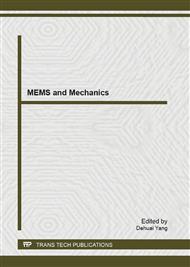p.516
p.523
p.528
p.534
p.540
p.546
p.553
p.561
p.565
Rigid Body Motion Conversion due to Collision
Abstract:
The impact phenomenon may be used for task-oriented changing of rigid body motion. When moving body encounters with some obstacle all parameters of motion are changing as a result of impact and trajectory and type of motion are also changing. In this work the conversion of translatory motion of prismatic rigid body into plane or rotation and conversion of plane motion of cylindrical body due to impact are considered. The conditions of conversion of one type of motion into another and parameters post-impact motion are studied. Problems are solved in the framework of rigid body motion, using rigid body impact theory. Studying of such phenomena is important for location of parts on industrial conveyors, feeders, etc.
Info:
Periodical:
Pages:
540-545
Citation:
Online since:
June 2013
Authors:
Keywords:
Price:
Сopyright:
© 2013 Trans Tech Publications Ltd. All Rights Reserved
Share:
Citation:


